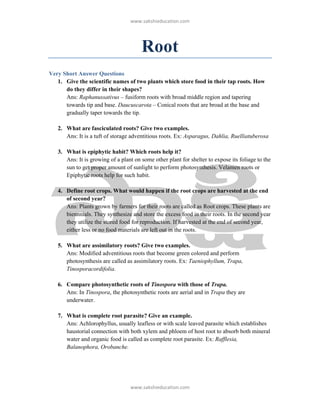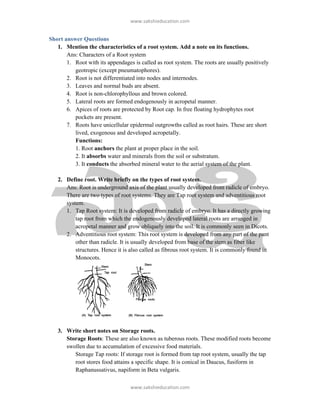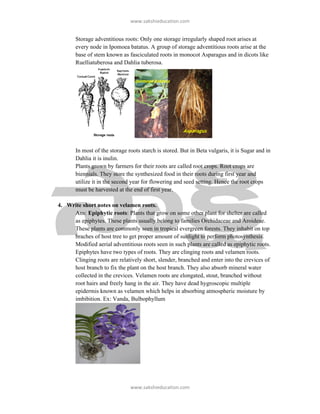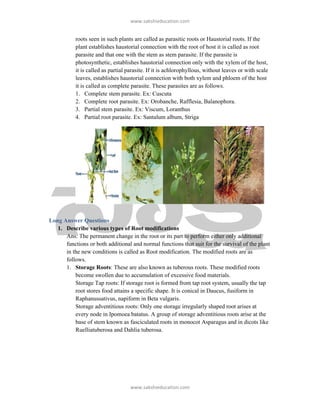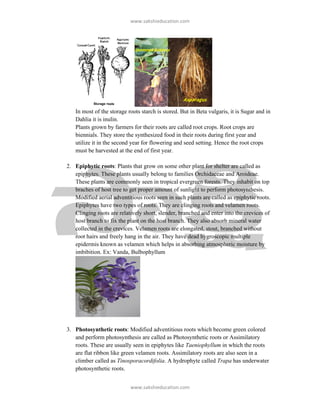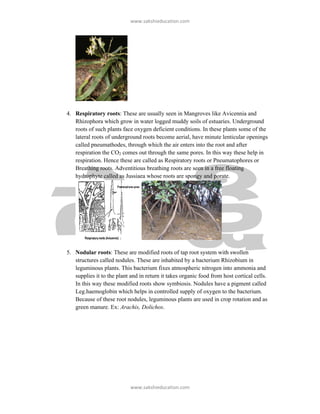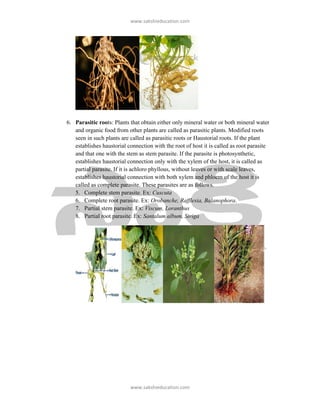Neha''s
- 1. ÃüÃüÃü═ÿãÉ─é┼¼ãÉ┼Ü┼Ø─×ãÛãÁ─É─éãÜ┼Ø┼¢┼Â═ÿ─É┼¢┼Á Root Very Short Answer Questions 1. Give the scientific names of two plants which store food in their tap roots. How do they differ in their shapes? Ans: Raphanussativus ÔÇô fusiform roots with broad middle region and tapering towards tip and base. Daucuscarota ÔÇô Conical roots that are broad at the base and gradually taper towards the tip. 2. What are fasciculated roots? Give two examples. Ans: It is a tuft of storage adventitious roots. Ex: Asparagus, Dahlia, Ruelliatuberosa 3. What is epiphytic habit? Which roots help it? Ans: It is growing of a plant on some other plant for shelter to expose its foliage to the sun to get proper amount of sunlight to perform photosynthesis. Velamen roots or Epiphytic roots help for such habit. 4. Define root crops. What would happen if the root crops are harvested at the end of second year? Ans: Plants grown by farmers for their roots are called as Root crops. These plants are biennnials. They synthesize and store the excess food in their roots. In the second year they utilize the stored food for reproduction. If harvested at the end of second year, either less or no food materials are left out in the roots. 5. What are assimilatory roots? Give two examples. Ans: Modified adventitious roots that become green colored and perform photosynthesis are called as assimilatory roots. Ex: Taeniophyllum, Trapa, Tinosporacordifolia. 6. Compare photosynthetic roots of Tinospora with those of Trapa. Ans: In Tinospora, the photosynthetic roots are aerial and in Trapa they are underwater. 7. What is complete root parasite? Give an example. Ans: Achlorophyllus, usually leafless or with scale leaved parasite which establishes haustorial connection with both xylem and phloem of host root to absorb both mineral water and organic food is called as complete root parasite. Ex: Rafflesia, Balanophora, Orobanche. ÃüÃüÃü═ÿãÉ─é┼¼ãÉ┼Ü┼Ø─×ãÛãÁ─É─éãÜ┼Ø┼¢┼Â═ÿ─É┼¢┼Á
- 2. ÃüÃüÃü═ÿãÉ─é┼¼ãÉ┼Ü┼Ø─×ãÛãÁ─É─éãÜ┼Ø┼¢┼Â═ÿ─É┼¢┼Á Short answer Questions 1. Mention the characteristics of a root system. Add a note on its functions. Ans: Characters of a Root system 1. Root with its appendages is called as root system. The roots are usually positively geotropic (except pneumatophores). 2. Root is not differentiated into nodes and internodes. 3. Leaves and normal buds are absent. 4. Root is non-chlorophyllous and brown colored. 5. Lateral roots are formed endogenously in acropetal manner. 6. Apices of roots are protected by Root cap. In free floating hydrophytes root pockets are present. 7. Roots have unicellular epidermal outgrowths called as root hairs. These are short lived, exogenous and developed acropetally. Functions: 1. Root anchors the plant at proper place in the soil. 2. It absorbs water and minerals from the soil or substratum. 3. It conducts the absorbed mineral water to the aerial system of the plant. 2. Define root. Write briefly on the types of root system. Ans: Root is underground axis of the plant usually developed from radicle of embryo. There are two types of root systems. They are Tap root system and adventitious root system. 1. Tap Root system: It is developed from radicle of embryo. It has a directly growing tap root from which the endogenously developed lateral roots are arranged in acropetal manner and grow obliquely into the soil. It is commonly seen in Dicots. 2. Adventitious root system: This root system is developed from any part of the pant other than radicle. It is usually developed from base of the stem as fiber like structures. Hence it is also called as fibrous root system. It is commonly found in Monocots. 3. Write short notes on Storage roots. Storage Roots: These are also known as tuberous roots. These modified roots become swollen due to accumulation of excessive food materials. Storage Tap roots: If storage root is formed from tap root system, usually the tap root stores food attains a specific shape. It is conical in Daucus, fusiform in Raphanussativus, napiform in Beta vulgaris. ÃüÃüÃü═ÿãÉ─é┼¼ãÉ┼Ü┼Ø─×ãÛãÁ─É─éãÜ┼Ø┼¢┼Â═ÿ─É┼¢┼Á
- 3. ÃüÃüÃü═ÿãÉ─é┼¼ãÉ┼Ü┼Ø─×ãÛãÁ─É─éãÜ┼Ø┼¢┼Â═ÿ─É┼¢┼Á Storage adventitious roots: Only one storage irregularly shaped root arises at every node in Ipomoea batatus. A group of storage adventitious roots arise at the base of stem known as fasciculated roots in monocot Asparagus and in dicots like Ruelliatuberosa and Dahlia tuberosa. /ãë┼¢┼Á┼¢─×─é ─Å─éãÜ─éãÜãÁãÉ ãÉãë─éãî─é┼ÉãÁãÉ In most of the storage roots starch is stored. But in Beta vulgaris, it is Sugar and in Dahlia it is inulin. Plants grown by farmers for their roots are called root crops. Root crops are biennials. They store the synthesized food in their roots during first year and utilize it in the second year for flowering and seed setting. Hence the root crops must be harvested at the end of first year. 4. Write short notes on velamen roots. Ans: Epiphytic roots: Plants that grow on some other plant for shelter are called as epiphytes. These plants usually belong to families Orchidaceae and Aroideae. These plants are commonly seen in tropical evergreen forests. They inhabit on top braches of host tree to get proper amount of sunlight to perform photosynthesis. Modified aerial adventitious roots seen in such plants are called as epiphytic roots. Epiphytes have two types of roots. They are clinging roots and velamen roots. Clinging roots are relatively short, slender, branched and enter into the crevices of host branch to fix the plant on the host branch. They also absorb mineral water collected in the crevices. Velamen roots are elongated, stout, branched without root hairs and freely hang in the air. They have dead hygroscopic multiple epidermis known as velamen which helps in absorbing atmospheric moisture by imbibition. Ex: Vanda, Bulbophyllum ÃüÃüÃü═ÿãÉ─é┼¼ãÉ┼Ü┼Ø─×ãÛãÁ─É─éãÜ┼Ø┼¢┼Â═ÿ─É┼¢┼Á
- 4. ÃüÃüÃü═ÿãÉ─é┼¼ãÉ┼Ü┼Ø─×ãÛãÁ─É─éãÜ┼Ø┼¢┼Â═ÿ─É┼¢┼Á 5. What are respiratory roots? Explain their role in mangrove plants. Ans: Respiratory roots: These are usually seen in Mangroves like Avicennia and Rhizophora which grow in water logged muddy soils of estuaries. Underground roots of such plants face oxygen deficient conditions. In these plants some of the lateral roots of underground roots become aerial, have minute lenticular openings called pneumathodes, through which the air enters into the root and after respiration the CO2 comes out through the same pores. In this way these help in respiration. Hence these are called as Respiratory roots or Pneumatophores or Breathing roots. Adventitious breathing roots are seen in a free floating hydrophyte called as Jussiaea whose roots are spongy and porate. 6. What are nodular roots? What is their significance? Nodular roots: These are modified roots of tap root system with swollen structures called nodules. These are inhabited by a bacterium Rhizobium in leguminous plants. This bacterium fixes atmospheric nitrogen into ammonia and supplies it to the plant and in return it takes organic food from host cortical cells. In this way these modified roots show symbiosis. Nodules have a pigment called Leg.haemoglobin which helps in controlled supply of oxygen to the bacterium. Because of these root nodules, leguminous plants are used in crop rotation and as green manure. Ex: Arachis, Dolichos. 7. Write short notes on parasitic roots. Ans: Parasitic roots: Plants that obtain either only mineral water or both mineral water and organic food from other plants are called as parasitic plants. Modified ÃüÃüÃü═ÿãÉ─é┼¼ãÉ┼Ü┼Ø─×ãÛãÁ─É─éãÜ┼Ø┼¢┼Â═ÿ─É┼¢┼Á
- 5. ÃüÃüÃü═ÿãÉ─é┼¼ãÉ┼Ü┼Ø─×ãÛãÁ─É─éãÜ┼Ø┼¢┼Â═ÿ─É┼¢┼Á roots seen in such plants are called as parasitic roots or Haustorial roots. If the plant establishes haustorial connection with the root of host it is called as root parasite and that one with the stem as stem parasite. If the parasite is photosynthetic, establishes haustorial connection only with the xylem of the host, it is called as partial parasite. If it is achlorophyllous, without leaves or with scale leaves, establishes haustorial connection with both xylem and phloem of the host it is called as complete parasite. These parasites are as follows. 1. Complete stem parasite. Ex: Cuscuta 2. Complete root parasite. Ex: Orobanche, Rafflesia, Balanophora. 3. Partial stem parasite. Ex: Viscum, Loranthus 4. Partial root parasite. Ex: Santalum album, Striga Long Answer Questions 1. Describe various types of Root modifications Ans: The permanent change in the root or its part to perform either only additional functions or both additional and normal functions that suit for the survival of the plant in the new conditions is called as Root modification. The modified roots are as follows. 1. Storage Roots: These are also known as tuberous roots. These modified roots become swollen due to accumulation of excessive food materials. Storage Tap roots: If storage root is formed from tap root system, usually the tap root stores food attains a specific shape. It is conical in Daucus, fusiform in Raphanussativus, napiform in Beta vulgaris. Storage adventitious roots: Only one storage irregularly shaped root arises at every node in Ipomoea batatus. A group of storage adventitious roots arise at the base of stem known as fasciculated roots in monocot Asparagus and in dicots like Ruelliatuberosa and Dahlia tuberosa. ÃüÃüÃü═ÿãÉ─é┼¼ãÉ┼Ü┼Ø─×ãÛãÁ─É─éãÜ┼Ø┼¢┼Â═ÿ─É┼¢┼Á
- 6. ÃüÃüÃü═ÿãÉ─é┼¼ãÉ┼Ü┼Ø─×ãÛãÁ─É─éãÜ┼Ø┼¢┼Â═ÿ─É┼¢┼Á /ãë┼¢┼Á┼¢─×─é ─Å─éãÜ─éãÜãÁãÉ ãÉãë─éãî─é┼ÉãÁãÉ In most of the storage roots starch is stored. But in Beta vulgaris, it is Sugar and in Dahlia it is inulin. Plants grown by farmers for their roots are called root crops. Root crops are biennials. They store the synthesized food in their roots during first year and utilize it in the second year for flowering and seed setting. Hence the root crops must be harvested at the end of first year. 2. Epiphytic roots: Plants that grow on some other plant for shelter are called as epiphytes. These plants usually belong to families Orchidaceae and Aroideae. These plants are commonly seen in tropical evergreen forests. They inhabit on top braches of host tree to get proper amount of sunlight to perform photosynthesis. Modified aerial adventitious roots seen in such plants are called as epiphytic roots. Epiphytes have two types of roots. They are clinging roots and velamen roots. Clinging roots are relatively short, slender, branched and enter into the crevices of host branch to fix the plant on the host branch. They also absorb mineral water collected in the crevices. Velamen roots are elongated, stout, branched without root hairs and freely hang in the air. They have dead hygroscopic multiple epidermis known as velamen which helps in absorbing atmospheric moisture by imbibition. Ex: Vanda, Bulbophyllum 3. Photosynthetic roots: Modified adventitious roots which become green colored and perform photosynthesis are called as Photosynthetic roots or Assimilatory roots. These are usually seen in epiphytes like Taeniophyllum in which the roots are flat ribbon like green velamen roots. Assimilatory roots are also seen in a climber called as Tinosporacordifolia. A hydrophyte called Trapa has underwater photosynthetic roots. ÃüÃüÃü═ÿãÉ─é┼¼ãÉ┼Ü┼Ø─×ãÛãÁ─É─éãÜ┼Ø┼¢┼Â═ÿ─É┼¢┼Á
- 7. ÃüÃüÃü═ÿãÉ─é┼¼ãÉ┼Ü┼Ø─×ãÛãÁ─É─éãÜ┼Ø┼¢┼Â═ÿ─É┼¢┼Á 4. Respiratory roots: These are usually seen in Mangroves like Avicennia and Rhizophora which grow in water logged muddy soils of estuaries. Underground roots of such plants face oxygen deficient conditions. In these plants some of the lateral roots of underground roots become aerial, have minute lenticular openings called pneumathodes, through which the air enters into the root and after respiration the CO2 comes out through the same pores. In this way these help in respiration. Hence these are called as Respiratory roots or Pneumatophores or Breathing roots. Adventitious breathing roots are seen in a free floating hydrophyte called as Jussiaea whose roots are spongy and porate. 5. Nodular roots: These are modified roots of tap root system with swollen structures called nodules. These are inhabited by a bacterium Rhizobium in leguminous plants. This bacterium fixes atmospheric nitrogen into ammonia and supplies it to the plant and in return it takes organic food from host cortical cells. In this way these modified roots show symbiosis. Nodules have a pigment called Leg.haemoglobin which helps in controlled supply of oxygen to the bacterium. Because of these root nodules, leguminous plants are used in crop rotation and as green manure. Ex: Arachis, Dolichos. ÃüÃüÃü═ÿãÉ─é┼¼ãÉ┼Ü┼Ø─×ãÛãÁ─É─éãÜ┼Ø┼¢┼Â═ÿ─É┼¢┼Á
- 8. ÃüÃüÃü═ÿãÉ─é┼¼ãÉ┼Ü┼Ø─×ãÛãÁ─É─éãÜ┼Ø┼¢┼Â═ÿ─É┼¢┼Á 6. Parasitic roots: Plants that obtain either only mineral water or both mineral water and organic food from other plants are called as parasitic plants. Modified roots seen in such plants are called as parasitic roots or Haustorial roots. If the plant establishes haustorial connection with the root of host it is called as root parasite and that one with the stem as stem parasite. If the parasite is photosynthetic, establishes haustorial connection only with the xylem of the host, it is called as partial parasite. If it is achloro phyllous, without leaves or with scale leaves, establishes haustorial connection with both xylem and phloem of the host it is called as complete parasite. These parasites are as follows. 5. Complete stem parasite. Ex: Cuscuta 6. Complete root parasite. Ex: Orobanche, Rafflesia, Balanophora. 7. Partial stem parasite. Ex: Viscum, Loranthus 8. Partial root parasite. Ex: Santalum album, Striga ÃüÃüÃü═ÿãÉ─é┼¼ãÉ┼Ü┼Ø─×ãÛãÁ─É─éãÜ┼Ø┼¢┼Â═ÿ─É┼¢┼Á

